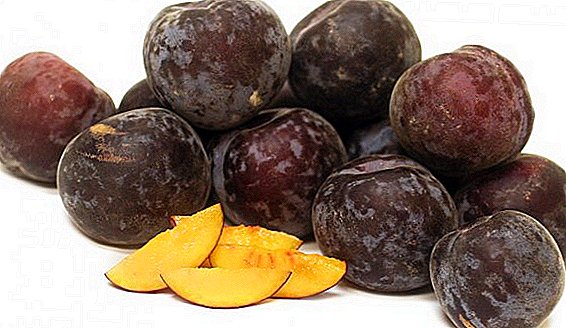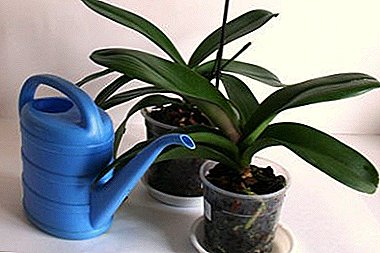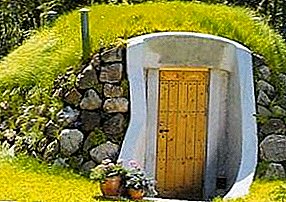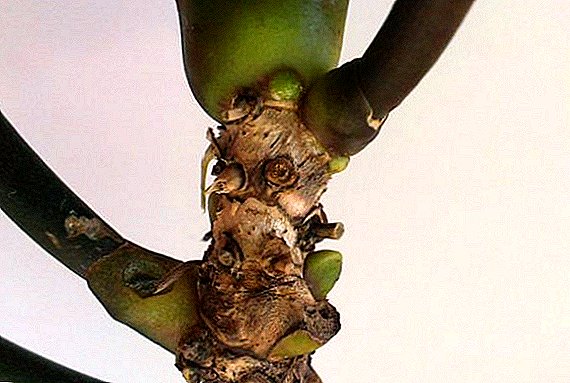 Orchid is considered quite fastidious house plant. Because of this, some newbies have a lot of problems in caring for a tropical flower. First, the balance of metabolism, which is imperceptible to the naked eye, is disturbed, and then the leaves wither and the root system dies. But often this problem can be solved if we take everything under our close control in time.
Orchid is considered quite fastidious house plant. Because of this, some newbies have a lot of problems in caring for a tropical flower. First, the balance of metabolism, which is imperceptible to the naked eye, is disturbed, and then the leaves wither and the root system dies. But often this problem can be solved if we take everything under our close control in time.
In this article, we will talk about how to reanimate the orchid, which began to putrid processes on the roots.
Plant description
Writing a detailed botanical description of flowers from the Orchid family is quite difficult from a scientific point of view.  In addition, it will take a lot of time. Here are 4 main features that are simultaneously found only among representatives of this family:
In addition, it will take a lot of time. Here are 4 main features that are simultaneously found only among representatives of this family:
- flowers have a mirror-type symmetry;
- in the natural habitat, orchid seeds can germinate only when interacting with symbiotic fungi;
- pollen grains are collected in special adhesive structures called pollinia;
- seed interior does not contain nutrients.
Did you know? Some types of orchids are able to continue their life cycle for 100 years.
In the wild, orchids grow in tropical forests with high humidity. Most often they are found on the African continent, namely in its northern part.
The rosette structure of the plant has wide dense leaves that are collected in a rosette. The size of the buds is quite variable (from 1 to 30 cm), and the flowers resemble a butterfly.
Depending on the type of Orchid, the number of flowers on the peduncle will be different (some species have more than 100 flowers on the same peduncle). 
Root system
The root system of ornamental orchids, which grow in the indoor environment of our climatic region, may differ from the root system of wild flowers of the Orchid family.
Among the room orchids are the so-called litofity and epiphytes. The roots of the former are adapted to grow in rocky terrain (some of them are in the air), and the roots of the latter are "airy" and do not require soil (epiphytes are plants that grow on other plants).
We recommend to get acquainted with the seven epiphytes for growing at home.
If your orchid grows from the soil and has a lithophyte root system, then it is important to know that the plant receives all the useful substances along with the moisture from the ground. Some types of orchids have a root system that resembles tubers in appearance.  These "tubers" actively absorb all the nutrients in the winter, when most tropical plants in our climate zone are in a dormant period.
These "tubers" actively absorb all the nutrients in the winter, when most tropical plants in our climate zone are in a dormant period.
Important! If during orchid resuscitation the temperature in the room or in the greenhouse is less than 20 ° C or more than 30 ° C, the growth of the roots will slow down significantly. In addition, such conditions will be favorable for the reproduction of pathogenic microflora.
The root system of epiphytes consists of the main element - velamen, which tries to extract moisture from raindrops, fog or dew. Belamen consists of a thick layer of dead cells that protect the plant from overheating.
Moreover, epiphytic orchids tolerate moisture deficiency quite well, as they are prepared for dry periods by evolution itself. It is believed that in normal healthy condition, the velamen should be bright white (a greenish or silver shade is allowed).
How healthy roots look like
Orchid roots, as they draw moisture from them, can shrivel and dry, but this fact does not mean that velamen die. Their color can be green, white, silver.  But a healthy root, when placed in moisture, will immediately swell up and be straightened, as it is saturated with moisture.
But a healthy root, when placed in moisture, will immediately swell up and be straightened, as it is saturated with moisture.
The dead roots do not react in any way to a moist environment.
Orchids have many varieties and species, among them: black orchids, Venus shoes, ludizii, Cattley, Bethilli, Phalaenopsis orchids, Wanda, celoginum, dendrobium, Cymbidium, Miltonia, Cumbria and oncidium.
Symptoms of the disease
It should be noted that the earlier it is possible to recognize the onset of the disease in an orchid, the greater the chances of success will be in the process of resuscitation. The first signs of illness are:
- If the flower grows in a transparent pot, then you can see a clearly visible scatter from spores or algae.
- The leaves begin to fade, become softer and more brittle (due to insufficient intake of moisture and nutrients that come from the roots).
- The orchid begins to wobble in a pot, since rotten roots are no longer able to create optimal density and keep the plant in a limited volume.
- The roots, which take moisture from the air, fade, change in color (darken), start to produce an unpleasant smell (sometimes it is weak, therefore, it is impossible to catch it immediately).
If you find at least one of the indicated signs of disease in your tropical flower, the plant must be removed from the pot and carefully examined the root system.  The main symptoms of the beginning of putrefactive processes in the roots are:
The main symptoms of the beginning of putrefactive processes in the roots are:
- the appearance of weeping areas;
- the rhizome tissue is decomposed into separate structural units;
- root system becomes dark brown or light black shade;
- when you press the velamen, a viscous dark-colored liquid with an unpleasant odor appears.
After the diagnosis is established, it is necessary to urgently move on to resuscitation therapy, because in this case the count goes not for days, but for hours.
Read also what to do if the orchid leaves turn yellow or fall, and also why there are sticky drops.
The reasons
Rotten processes in the root system begin due to improper care or after being affected by pests and diseases. The main causes of pathological processes are:
- Overly frequent and abundant watering. Adequate amount of sunlight is needed to dry the soil. It is necessary to water only dry soil.
- Dense ground. It is important to note that Orchid roots are used to constantly contact with oxygen masses. If the soil is excessively dense, oxygen will not reach the roots and rotting will begin.
- Mechanical damage. If the roots were damaged during transplantation, then bacteria and other pathogens are likely to fall into them, which will cause rot.
- Fanatic fertilizer. Remember that you need to fertilize orchids without fanaticism, since a large dose of minerals can lead to chemical burns and the death of the roots.
- Pests. Excessively moist soil can become a place for small parasites to live in - sub-cicatrices, and that is what can cause rotting of the root system of a flower.
- Sunlight in insufficient quantities. The structure of an orchid is arranged in such a way that the roots cannot transport moisture without enough light. That is, they will absorb it, but will not be able to serve the leaves. As a result, the stagnation of moisture will lead to pathology of the roots.
- Fungal diseases. Sometimes the soil you are preparing for planting an orchid contains micro-fungi. On the leaves of the affected plant appear yellow spots, the roots begin to rot. In addition, fungi often appear in waterlogged soils.

Did you know? Some species of the Orchid family can reach a height of 20 m.
How to grow roots
It is necessary to increase the roots in cases where it is no longer possible to reanimate old ones. Tell you about the method of building roots above water.
Rotten roots are cut so as not to injure living tissue. Slices should be treated with activated charcoal or fungicide in powder form. It is important to understand that wilted, but not yet withered leaves should not be removed.
The fact is that in the future they will be reanimated, and in the process of growing roots will play the necessary role for survival.
Next, you should choose a suitable container for orchids. This may be the most common disposable cup, but with parameters such that the plant placed in it does not come into contact with water.  Container with a flower should be put on a well-lit place.
Container with a flower should be put on a well-lit place.
Learn how to choose a primer and a pot for an orchid.
If you are engaged in growing the roots in winter, you should create a long artificial light for a tropical guest.
Water is poured on the bottom with a small layer, preferably sweetened. Every day (for 60-90 minutes) the plant is immersed in water with glucose.
An important step in the process of growing roots is the regular wiping of the leaves with an aqueous solution of succinic acid.
For wiping, you can use a conventional cotton pad.  The solution is prepared as follows: half a tablet of succinic acid is dissolved in half a glass of warm water. It is necessary to wipe every morning at the same time.
The solution is prepared as follows: half a tablet of succinic acid is dissolved in half a glass of warm water. It is necessary to wipe every morning at the same time.
Important! After cutting the roots, the growth zone of the flower should be treated with a growth stimulator. Such a procedure will increase the plant immunity and speed up the rooting process.
It should be understood that the temperature when growing roots must be within + 23 ... +26 ° C.
Top dressing is carried out not more than 1 time per week. Almost the entire period of growth of the orchid root system should be suspended.
How to save an orchid
For orchid resuscitation, you should use the following step-by-step actions:
- Get the "sufferer" from the pot, remove the remnants of the soil and visually assess the scale of the disaster.
- Rinse the roots with clean water at room temperature.
- Completely remove all rotten tissues after disinfecting the trimming tool.
- Slices cover with activated carbon or powder fungicide.
- If a mold was detected during the inspection, then the plant should be carefully treated with an aqueous solution of potassium permanganate.
- Plant the plant in a small pot (6-8 cm) in diameter, but only on condition that there are still a few living roots left on the orchid. The soil should not be sufficiently dense (you can make a mixture of peat, humus, expanded clay, moss and coconut fiber).
- Provide coverage of at least 12 hours a day. At the same time, to maintain a constant temperature within + 22 ... +26 ° С.
- Maintain high humidity in the room. To do this, you can purchase a special installation that creates fog.
- Watering is very rare and only if the soil is completely dry.
Video: how to reanimate the orchid Fresh roots will appear in 20-25 days. In some cases, this process is accelerated, but only under the condition of proper care and special feeding, which will be discussed below.
Did you know? The most expensive orchid in the world was sold in the USA in 1952 for 4,500 thousand dollars.
Sheet top dressing
Sheet top-dressing is made by special liquid preparations that deliver a multitude of beneficial substances to the flower through the suction ability of the leaves.
Top dressing allows normal functioning of all orchid systems during the period when the root system is not able to supply nutrients.  It is important to note that the soil should be slightly moist before foliar application. The procedure is best carried out in the early morning or late evening, as during the daytime the sun's rays in combination with fertilizing can cause chemical burns in the orchid.
It is important to note that the soil should be slightly moist before foliar application. The procedure is best carried out in the early morning or late evening, as during the daytime the sun's rays in combination with fertilizing can cause chemical burns in the orchid.
It will be useful for you to learn how to feed indoor plants.
It should also be noted that dressing should not fall on the flowers and buds.
If there are no roots
In this case, it is necessary to grow the roots for the plant, and only then transplant into the prepared substrate. For this you need to perform the following step-by-step actions:
- In a water solution of a growth stimulator, lower the plant separated from the rotten roots with a growth point.
- In a container with boiled water put a tablet of activated carbon.
- Move the plant to a container with coal (water should cool to +25 ° C).
- During the period of growing roots in the room should be high humidity and air circulation.
- Periodically wipe the leaves with a solution of succinic acid or sugar solution.
- When you notice that some water has evaporated, you need to add liquid to the required level, and the temperature difference should not exceed 3 ° C.
 After about 2 months, the roots will grow and reach a length of 6-7 cm. Only then the orchid can be transplanted into the substrate.
After about 2 months, the roots will grow and reach a length of 6-7 cm. Only then the orchid can be transplanted into the substrate.If there are no roots and leaves
In this case, it will be much more difficult to save the orchid, but still, with proper care, there are chances of success. For resuscitation, the plant should be treated in the same way as in the previous case, the conditions of detention remain the same.
That's just to plant an orchid is necessary in the moss. Watering occasionally (for 1 watering use no more than 1 tablespoon of water). Moss contributes to the retention of moisture and its structured distribution. After the first roots appear, the orchid should be transplanted into the soil.
We also advise you to read how to water an orchid, how to make it blossom, how to propagate, replant and care for an orchid that has faded.
If the algae on the roots
Algae on the roots of an orchid may appear due to an excess of minerals or natural light.. It is important to understand that green algae worsens substrate aeration, changes its chemical composition and secrete some toxic substances. Therefore, when green algae appear on the roots of an orchid, appropriate measures should be taken immediately to save the flower. These measures will consist of the following actions:
- It is necessary to rinse the roots of an exotic flower in 0.1% solution of potassium permanganate 2-3 times.
- For species of orchids, whose root system does not need regular lighting, you can use a trick: wrap a transparent pot with foil. In this case, the light will cease to flow to the roots and algae, with the result that the latter will eventually die.
- In case of severe damage, washing the roots in a bleach solution is recommended.

In greenhouse conditions
If you have a window greenhouse, where you can constantly maintain the optimum temperature and humidity, then the chances to reanimate a weakened orchid will increase several times.
At the bottom of the greenhouse should be laid claydite, and on top of it - carefully steamed sphagnum moss. In such a substrate is placed a sheet rosette. Until the orchid grows roots 4-5 cm long, the following conditions should be maintained in the greenhouse:
- humidity within 75 ... 95%;
- temperature should not exceed + 23 ... +27 ° С;
- bright lighting should be maintained for 12-14 hours a day.
Important! If you root an orchid in the soil, do not forget about its regular replacement. Otherwise, the substrate will condense and the plant will die.
The probability of a successful outcome of resuscitation in the greenhouse is 80%. Such a high figure is due to meticulous care: regular airing at night, watering as the substrate dries out, maintaining an optimal microclimate.
Without greenhouse
In this case, you can follow the information provided in the section "If there are no roots." However, there is a way to speed up the rooting process and increase the chances of success.  Should be regular feeding:
Should be regular feeding:
- complex mineral fertilizers to dissolve in water (concentration should not exceed 1%);
- regularly feed the ferum minerals;
- every 2-3 weeks process growth regulators.
Read also how to apply for plants such growth regulators: "Chunky", "Etamon", "Bud", "Charm", "Vympel", "Ekosil", "Prophet", "Immunocytophit" and "Zircon".
Finally, we note that the process of reanimation of an orchid can take a long time (sometimes more than 2 months). But the rate of resuscitation and the probability of a successful outcome will depend only on the grower, who should be guided by the rules described in this article. We must remember about the microclimate, dressing, correct removal of old roots and treatment of wounds.
Feedback from network users














